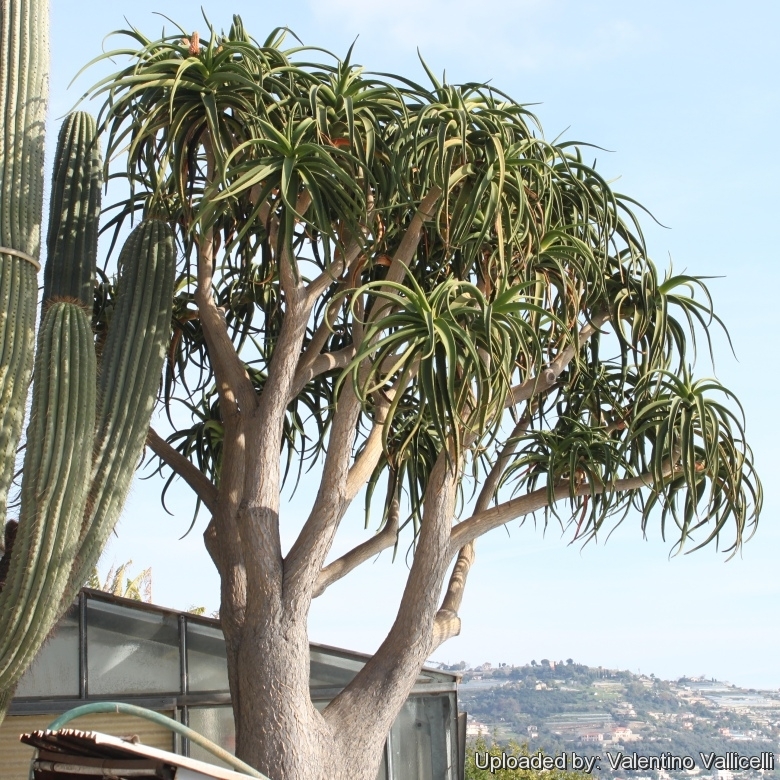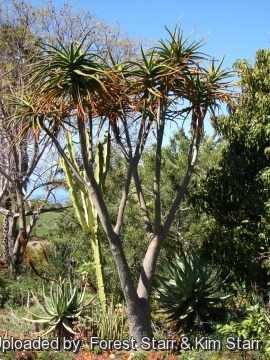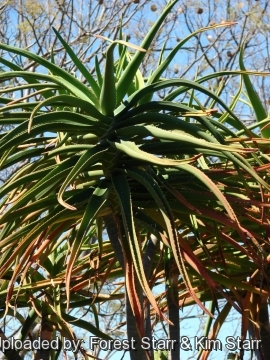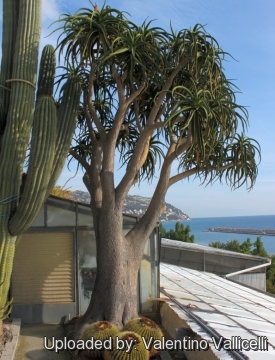




Your support is critical to our success.

Origin and Habitat: Eastern Cape through the former Transkei, KwaZulu-Natal, Swaziland and Mpumalanga; and northwards to Mozambique and East Africa.
Habitat: It occurs in wooded ravines in subtropical coastal forests and dry valleys in the summer rainfall eastern regions of southern Africa. The climate is mild and rainfall is at least 1000-1500 mm per annum and with little or no frost. The seeds often germinate in the shade of mother plants and eventually outgrow them. The soil is usually a loam and humus rich.
Synonyms:
- Aloe barberae Dyer
- Aloe bainesii Dyer
- Aloe bainesii var. barberae (Dyer) Baker
- Aloe zeyheri hort. ex Baker
- Aloidendron barberae (Dyer) Klopper & Gideon F.Sm.
ENGLISH: Tree aloe, South African tree aloe
AFRIKAANS (Afrikaans): Boomaalwyn, Mikaalwyn
ZULU (isiZulu): umGxwala, inDlabendlazi, imPondondo, imPondonndo, inKalane enkulu (= the big one)
Description: The South Africans tree aloe Aloe barberaeSN|980]]SN|26265]] ( known for many years as Aloe bainesiiSN|26265]]SN|980]]), is a small to medium-sized, much-branched tree with a massive trunk and high rounded crown that can take a variety of shapes and sizes. In its native land this slow-growing tree can reach 18-20 m high. It is widely used as an ornamental plant in tropical and Mediterranean gardens and can certainly be described as a timeless classic. Aloe barberae is Africa's largest aloe.
Stem: Trunk, single, erect 0,9-3 m in diameter, copiously branching dichotomously (either two or three-forked). The bark of the tree trunks is greyish-brown and rough to the touch. The branches are long, arm-like, tapering, naked, and sprout rosettes of long and narrow leaves at their ends.
Leaves: About 20 per rosette, 60-90 cm long, 7-9 cm broad, deeply channelled, recurved, dark green, spineless on both surfaces. Margin edged with a whitish line and small brown-tipped teeth, that are, firm horny, 2-3 mm long and 10-25 mm apart.
Inflorescence: 40-60 cm long, erect, simple or divided into three side branches (mostly 2-branched). Racemes cylindrical, slightly acuminate, 20-30 cm long and 8-10 cm in diameter, dense. Bracts linear-acuminate, 10 mm long, 1 mm broad. Pedeicel up to 10 mm long.
Flowers: Tubular, rose-pink or oran ge (Maputaland coastal form) and green-tipped 33-37 mm long. Base rounded. Tepals free for 28-32 mm long. Stamens exserted 15 mm long.
Blooming season: It flowers in winter (June and July in habitat) and in its natural environment is pollinated by sunbirds.
Fruits: Dry capsules. The capsules ripen during late spring and release their seed which is wind dispersed.
Chromosome number: 2n = 14
Notes: This species was previously known as Aloe bainesiiSN|26265]]SN|980]] Dyer, a name published in the same paper as Aloe barberaeSN|980]]SN|26265]]. A few months later Dyer published a note in which the 2 taxa were united, and he chose A. barberae as the name for the united species. This later note was overlooked until attention was drawn toil by Smith & al. (1994). In accordance with ICBN Art. 11.5, Dyer's choice of name must be used.
Bibliography: Major references and further lectures
1) 1) Forest & Kim Starr “Aloe barberae (Tree aloe)”. Plants of Hawaii. <http://www.starrenvironmental.com>. Web. 27 Sep. 2014.
2) Nichols,G. “A great sculptural species.” Farmers Weekly 29June:p.87 2001
3) Urs Eggli “Illustrated Handbook of Suculent Plants: Monocotyledons” Springer, 2001. Pages 114-115
4) Susan Carter, John J. Lavranos, Leonard E. Newton, Colin C. Walker “Aloes. The definitive guide” Kew Publishing, Royal Botanic Gardens, Kew 2011, ISBN 978-1-84246-439-7, S. 251.
5) Court, D, 1981. “Succulent flora of Southern Africa” Balkema, Cape Town.
6) Germishuizen, G. & Meyer, N.L. (eds) 2003. “Plants of southern Africa : an annotated checklist.” Strelitzia 14. National Botanical Institute, Pretoria.
7) Jackson, W P U, 1990. “Origins and meanings of South African plant genera” UCT Ecolab, Cape Town.
8) Gordon D. Rowley “The illustrated encyclopedia of succulents” Crown Publishers, 01/Aug/1978
9) Leistner, O.A. 2005. “Seed plants of southern tropical Africa” SABONET, Pretoria.
10) Nichols, G. 2005. “Growing rare plants, a practical handbook on propagating the treatened plants of southern Africa” Southern African Botanical Diversity Network Report No. 36. SABONET, Pretoria.
11) Reynolds, G.W. 1950. “The aloes of South Africa” The Aloes of South Africa Book Fund, Johannesburg.
12) Van Jaarsveld, E., Van Wyk, B-E. & Smith, G. 2000. “Succulents of South Africa” Cape Town , Tafelberg
13) Hans Bornman, David S. Hardy “Aloes of the South African veld” Voortrekkerpers, 1971
14) Barbara Jeppe “South African aloes” Purnell, 1974
15) Ben-Erik Van Wyk, Gideon Smith “Guide to the Aloes of South Africa” Briza Publ., 1996.
16) Smith, C.A. 1966. “Common names of South African plants.” Memoirs of the Botanical Survey of South Africa No. 35.
17) Van Wyk, B.-E. & Gericke, N. 2000. “People's plants. A guide to useful plants of southern Africa” Briza Publications, Pretoria.
18) Van Wyk, B-E. & Smith, G. 1996. “Guide to the aloes of South Africa” Briza Publications, Pretoria.
19) Keith, Paul & Meg Coates Palgrave. “Algemene gids tot BOME” 2000.
20) Van Wyk, Piet “Field guide to the TREES of the Kruger National Park." Struik. 2008
21) Smith, G.F., Van Wyk, B.-E. & Glen. H.F. “Asphodelaceae/Aloaceae: Aloe barberae to replace A. bainesii.” Bothalia 24: 34–35.
22) Umberto Quattrocchi “CRC World Dictionary of Medicinal and Poisonous Plants: Common Names, Scientific Names, Eponyms, Synonyms, and Etymology” (5 Volume Set) CRC Press, 03/mag/2012
23) Braam Van Wyk, Piet Van Wyk “Field Guide to Trees of Southern Africa” Struik, 1997
24) Smith,G.F. et al. “Aloe barberae to replace A.bainesii.” Bothalia 24(1)34-35. 1994.

Habit at Enchanting Floral Gardens of Kula, Maui, Hawaii (USA). February 19, 2008. Photo by: Forest Starr & Kim Starr

Aloe barberae Photo by: Valentino Vallicelli

Leaves at Enchanting Floral Gardens of Kula, Maui, Hawaii (USA). February 19, 2008. Photo by: Forest Starr & Kim Starr

Aloe barberae Photo by: Valentino Vallicelli
Cultivation and Propagation: Aloe barberaeSN|26265]]SN|26265]] is an attractive and interesting accent plant to have in a sunny garden. It easy to grow and suited for any well drained soil in full sun. As such it is increasingly used as an ornamental plant for drought tolerant landscaping and rockeries.
Growing rate: It is fairly fast growing, but should be well watered and enough compost provided for optimal growth. It is able to increase its height by 10-30 cm per year under favourable conditions. It is a long lived plant and once established, it will be content in its position and with its soil for years. It is often in danger of being overgrown, smothered and killed by faster growing plants in its vicinity.
Soil: Always use a good quality, loamy sandy soil with plenty of drainage chips at the bottom of containers. It prefers soil of a medium or slightly acidic pH. Outdoors always provide a well-drained site, on a slope is best. Enough space should be provided for its eventual size.
Fertilization: It needs a perfect fertilizer diet in summer. Use preferably a cacti and succulents fertilizer with high potassium content including all micro nutrients and trace elements or slow release fertilizer.
Exposure: Full sun. It can tolerate moderate shade, and a plant that has been growing in shade should be slowly hardened off before placing it in full sun as the plant will be severely scorched if moved too suddenly from shade into sun.
Watering: It tolerates weekly watering in the summer; once a month, or not at all in the colder months of winter. Can withstand long periods of drought, but they will thrive and flower more profusely if watered in the correct season.
Pest & diseases: Incorrect watering, poor drainage or too much shade can lead to attack by pests and diseases. Rot it is only a minor problem with aloes if the plants are watered and “aired” correctly. If they are not, fungicides won't help all that much. The leaves may be attacked by aphids and scale insects, which are controlled with an oil-based spray.
Hardiness: It is sensitive to frost and in a frost-prone area should be protected in the first few years of its life, but prefers hot summers. It grows much better outdoors in spring and summer.
Gardening and landscaping: In mild climates Aloe barberaeSN|26265]]SN|26265]] can be cultivated outdoors for use in landscaping, preferably planting it in hot and dry rock gardens. It forms a striking focal point in the garden, being an enormous sculptural tree with a neat crown. It will grow best in regions with a climate close to that of its native deserts – not too cold, and not too wet. Due to its massive stem base, it should preferably not be planted close to any buildings. It can be grown in large containers too.
Medicinal uses: the juice is purgative.
Propagation: It is easily cultivated from truncheons and smaller stem cuttings, as well as seed planted in autumn, in trays of coarse river sand. Cuttings must be dried out for at least 3 weeks before planting in river sand. Growing a mature plant from a seedling or single stem cutting would be a lifetime's work but by good fortune larger cuttings, sometimes known as truncheons with several branches and leaf-rosettes, can be rooted, but this may take several months and success is not always guaranteed.
| Your Actions | |
|---|---|
| Back to Aloe index | |
| Back to Aloaceae index | |
 |
Back to Trees Encyclopedia index |
Privacy stantement - Terms and conditions - How to cite - About us - Feedback - Donate


